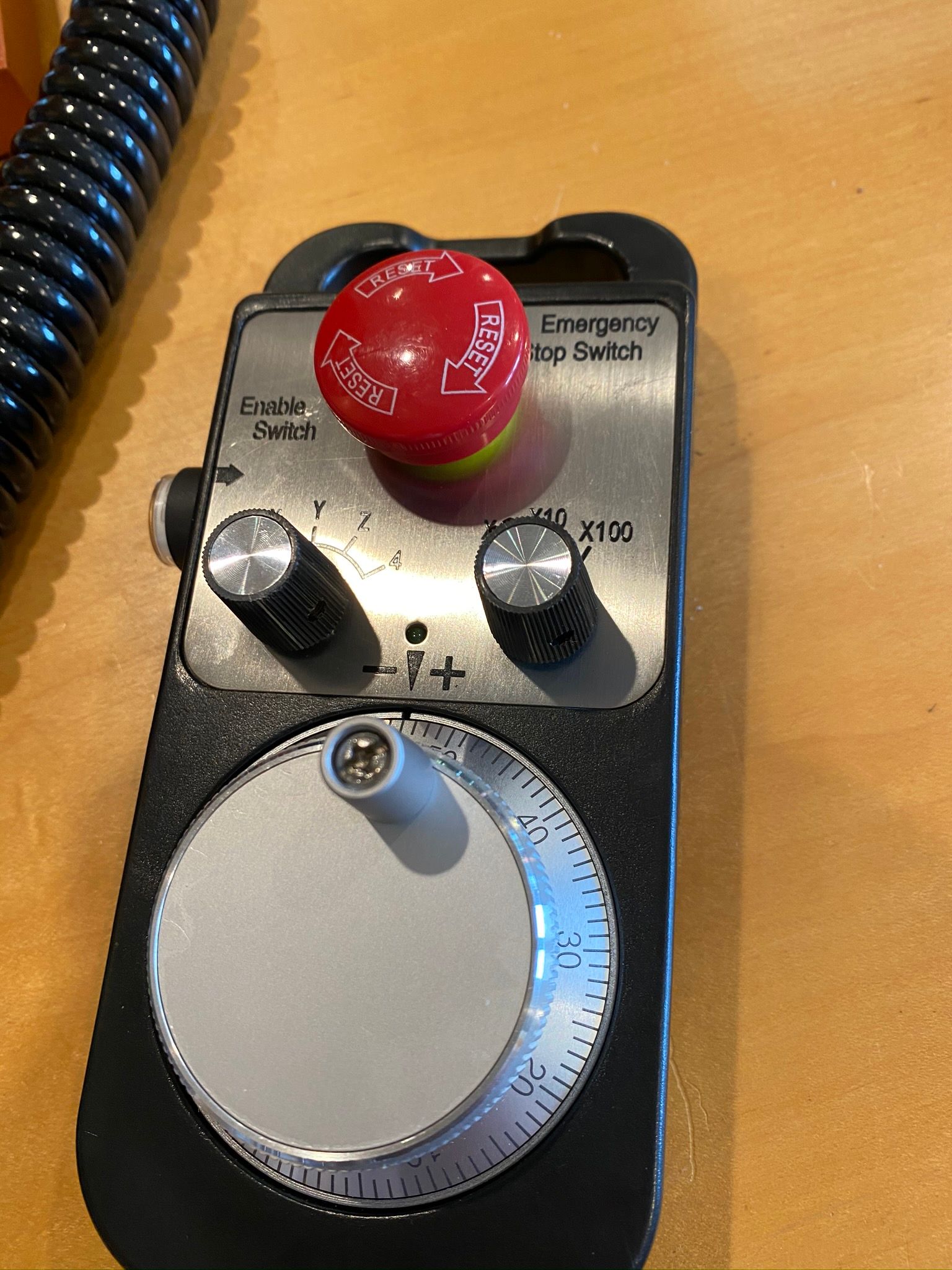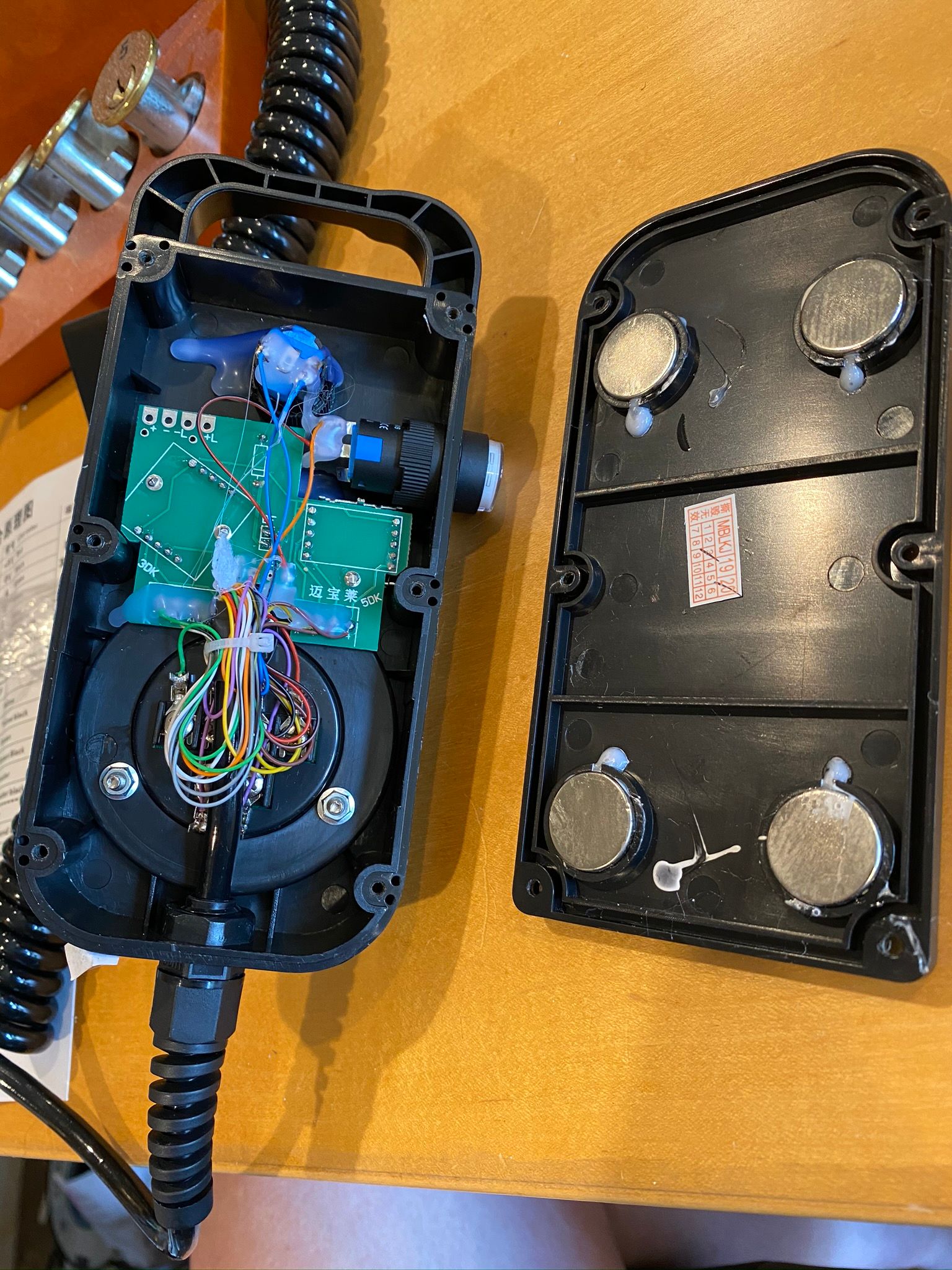CNC style Pendant
-
@FelixH said in CNC style Pendant:
would it be possible to just attach a switch on the UTXD0 and URXD0
double pole double throw switch should work without a problem for this purpose selecting one or the other device
-
@dc42 said in CNC style Pendant:
I've written the Arduino Nano code for the pendant-to-PanelDue-port interface
question. are you sending many short G0 while receiving impulses from the encoder or you scan at a certain frequency (e.g. 2Hz or 10Hz) and then send G0 according to what encoder did between scans? I'm making this wifi pendant for a while now and having issues deciding what I want. First version I made with buttons, then replaced buttons with a stick but now stick is behaving like buttons (you have to move stick for each movement and select increment on other button) and I don't like it. now I'm attaching analog stick so I can use 2-3 different speeds according to the angle of the stick but again, don't know if I wanna send ton of 0.1-10mm gcode's in a loop, or do 2Hz scan and send only gcode's at that frequency. You for sure have more experience with this so know what might be better solution. I guess analog stick is similar to the encoder so decisions should be similar :). Now I'm thinking about adding encoder to the stick too
 (I'm never going to finish this, first screen, then stick, then analog stick, now encoder... neverending story).
(I'm never going to finish this, first screen, then stick, then analog stick, now encoder... neverending story).p.s. I didn't want to go with "ready made pendant" as they were "expensive", now looking at %$#^^@$# I crammed in to the box it's more expensive than ebay

-
@arhi said in CNC style Pendant:
question. are you sending many short G0 while receiving impulses from the encoder or you scan at a certain frequency (e.g. 2Hz or 10Hz) and then send G0 according to what encoder did between scans?
I've written it to accumulate movement from the encoder and send it only when the UART transmit buffer is empty. I suspect this will still be too often, and I will need to send it every X milliseconds instead, or immediately if we haven't sent a command for the last X milliseconds.
-
Yesterday I got my Pendant, exactly as the one pictured. I could start working on the implementation on my spare time
-
@FelixH said in CNC style Pendant:
Yesterday I got my Pendant, exactly as the one pictured. I could start working on the implementation on my spare time
I'm still waiting for mine, but feel free to try my code. It's at https://github.com/Duet3D/CNC-Pendant-Firmware.
-
Serial.write("M112 ;" "\xF0" "\x0F" "\n");any special reason for 0xF00F between M112 and 0x0A ? I see it comes after ; so it's a comment but ?
-
It's a special emergency stop code recognised by the input buffer code on the Duet, so that the emergency stop command bypasses the command buffers.
-
@dc42 great, good to know

-
int distance = encoder.getChange() * distanceMultiplier; if (axis >= 0 && distance != 0) { whenLastCommandSent = now; Serial.write("G91 G0 "); Serial.print(distance); Serial.write('\n'); }seems to me axis is missing from the G0 ?
-
That's because I failed to complete a recent change. Change the line:
Serial.write("G91 G0 ");
to:
Serial.write(MoveCommands[axis]);
-
@dc42 do you think it's better for wireless pendant to telnet to the RRF and send G-codes or to exec g-codes trough http://rrf/rr_gcode ?
-
@arhi said in CNC style Pendant:
@dc42 do you think it's better for wireless pendant to telnet to the RRF and send G-codes or to exec g-codes trough http://rrf/rr_gcode ?
If you use http, you can use the pendant with either a Duet in standalone mode or via the DSF (with a slight change to the URL).
-
@gtj0 that's the reason I'm asking. HTTP approach looks better but dunno if there are penalties. I went forward last night and since I need a "send g-code" function in one place only it's not a big deal to have few different ones (one for telnet, one for http, one for - whatever...) as it will not be affecting the code.
I took a 2stick module from some broken game controller, that gives me 2 buttons + 4 axes with limited speed control (2k2 pots on the axes are not very precise, I can safely detect 2 speeds, maybe 3 especially as I added 4k7 in series so the swing is even lower, I might remove the 4k7 but 4x2k2 in parallel on the 3v3 rail is 6mA constant drain on the battery), attached to ESP32+BMS.
Telnet works for now but I'm still thinking if I need to add more buttons
 and leds.
and leds. -
Somewhere in all the above I ordered a pendant a few weeks back. JUST after I ordered it, Dave published his code. Which is great, not having to write it... so I haven't done much since then.
I have received the pendant now.
I'm thinking about an ESP32 (massive, massive, overkill, but they are $5 each...!) setup to do Serial or Network, including RRF2 or RRF3 printers. And just experimenting to see if it "feels" right when hooked up by various methods.
And a battery and an "off the shelf" USB charger/manager for the battery.
Going back and forth on having a small display, XYZ.


-
@Danal Lock picking for fun and profit??

-
Ooops... need to move that.
You nailed the goal. That is my practice set, they get progressively harder. Keep the 'ol fingers skilled up.
-
@Danal The LockPickingLawyer is my hero.
-
Arduino Nano to Duet PanelDue connector connections: Nano Duet +5V +5V GND GND TX1/D0 Through 5K6 resistor to URXD, also connect 10L resistor between URXD and GND */I don't have any 5K6 resistor at home, and I don't feel like driving 75 km to get one. Is there any way to make this connection possible? My 2 ideas are:
- Using a 3.3 to 5 v logic converter
- Using a 3.3v board to drive the pendant (I have some overkill ESP32 on stock)
Also, I'm guessing that 10L means to be 10K, right?
-
Yes 10L should be 10K. You need 2 resistors with a resistance ratio of 2:1 or a little less. For example, 10K and 18K. Or 6K8 and 10K. Or, if you have lots of 10K resistors, 5K (i.e. 2 of them in parallel) and 10K. Even 10K and 10K will probably work. The idea is to reduce the 5V output from the UART on the Arduino Nano to somewhere between 2.5V and 3.3V.
The sheet that came with the pendant says it needs a 5V supply for the rotary encoder. Maybe it will work on 3.3V, maybe not.
-